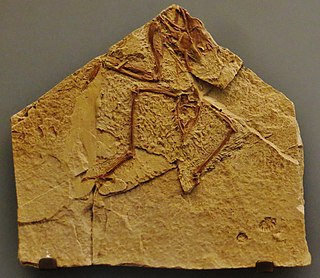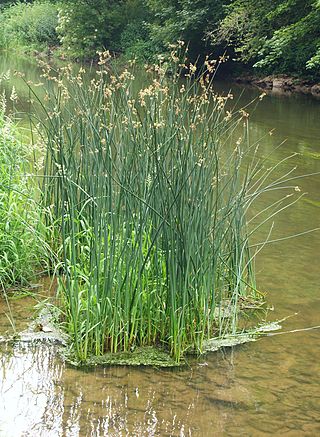
Acanthocephala is a group of parasitic worms known as acanthocephalans, thorny-headed worms, or spiny-headed worms, characterized by the presence of an eversible proboscis, armed with spines, which it uses to pierce and hold the gut wall of its host. Acanthocephalans have complex life cycles, involving at least two hosts, which may include invertebrates, fish, amphibians, birds, and mammals. About 1420 species have been described.

Isoetes lacustris, the lake quillwort or Merlin's grass, is a boreal quillwort native on both sides of the northern Atlantic Ocean. Synonyms include Isoetes hieroglyphica.
This article gives an overview of the swamp and tall-herb fen communities in the British National Vegetation Classification system.
Chiayusaurus is a genus of sauropod dinosaur known from teeth found in China and possibly also South Korea. Two species have been named for this obscure genus, though only the type, C. lacustris, is still seen as valid. It was originally named as Chiayüsaurus, but the ICZN does not permit special characters, so the name was corrected to Chiayusaurus. The obsolete name can still be seen in older sources, though. As a sauropod, Chiayusaurus would have been a large, quadrupedal herbivore.

Iris lacustris, the dwarf lake iris, is a plant species in the genus Iris, subgenus Limniris and in the section Lophiris. It is a rhizomatous, beardless perennial plant, native to the Great Lakes region of eastern North America. It has lavender blue or violet-blue flowers, a very short stem and long fan-like green leaves. It is cultivated as an ornamental plant in temperate regions. It is closely related to Iris cristata.
The Tanzanian vlei rat is a species of rodent in the family Muridae. It is found in Kenya, Malawi, and Tanzania. Its natural habitats are subtropical or tropical high-altitude grassland and swamps. It is threatened by habitat loss.
The Lake Chad gerbil or Lake Chad tateril is a species of rodent found in Cameroon and Nigeria. Its natural habitats are dry savanna, subtropical or tropical dry shrubland, and arable land.

The Lake Kutubu rainbowfish is a species of fish in the family Melanotaeniidae. It is also known as turquoise rainbowfish. It is one of 13 fish endemic to Lake Kutubu, a lake found within the Kikori River system in Papua New Guinea.

Concornis is a genus of enantiornithean birds which lived during the early Cretaceous period, in the late Barremian age about 125 million years ago. Its remains are known from the Calizas de La Huérgina Formation at Las Hoyas, Cuenca province, Spain. The single known species, Concornis lacustris, was described from the remains of one fairly complete individual skeleton.

Acroloxus lacustris, or the lake limpet, is a small freshwater limpet or snail, a species of aquatic gastropod mollusk in the family Acroloxidae.

Gerris lacustris, commonly known as the common pond skater or common water strider, is a species of water strider, found across Europe.

Amarinus lacustris is a species of freshwater crab from Australia, New Zealand and nearby islands, where it lives in water of various salinities. It grows up to 10 mm (0.4 in) wide, with an H-shaped groove on its back. It is an omnivore and is eaten by crayfish and fish. It was first discovered in Lake Pupuke, near Auckland, and is the only freshwater crab in New Zealand.
Professor Friedrich Kiefer was a German zoologist, specialising in freshwater copepods. For over 60 years, he was "the preeminent morphological taxonomist of continental free-living copepods".

Gammarus lacustris is an aquatic amphipod.

Spongilla lacustris is a species of freshwater sponge from the family Spongillidae. It inhabits freshwater rivers and lakes, often growing under logs or rocks. Lacustris is a Latin word meaning "related to or associated with lakes". The species ranges from North America to Europe and Asia. It is the most common freshwater sponge in central Europe. It is the most widespread sponge in Northern Britain, and is one of the most common species of sponges in lakes and canals. Spongilla lacustris have the ability to reproduce both sexually and asexually. They become dormant during winter. The growth form ranges from encrusting, to digitate, to branched, depending upon the quality of the habitat.
Delftia lacustris is a Gram-negative, nonfermentative, motile, rod-shaped bacterium from the family Comamonadaceae, which was isolated from mesotrophic lake water in Denmark. It has the ability to degrade peptidoglycan through chitinase and lysozyme activity.

Carex lacustris, known as lake sedge, is a tufted grass-like perennial of the sedge family (Cyperaceae), native to southern Canada and the northern United States. C. lacustris us an herbaceous surface-piercing plant that grows in water up to 50 cm (1.6 ft) deep, and grows 50–150 cm (1.6–4.9 ft) tall. It grows well in marshes and swampy woods of the boreal forest, along river and lake shores, in ditches, marshes, swamps, and other wetland habitat. It grows on muck, sedge peat, wet sand or silt, in filtered or full sunlight.

Schoenoplectus lacustris, the lakeshore bulrush or common club-rush, is a species of club-rush that grows in fresh water across Europe and some neighbouring areas.

Temora is a genus of copepods in the family Temoridae. The World Register of Marine Species lists the following species:

Eurytemora is a genus of copepods in the family Temoridae. The World Register of Marine Species lists the following species:













